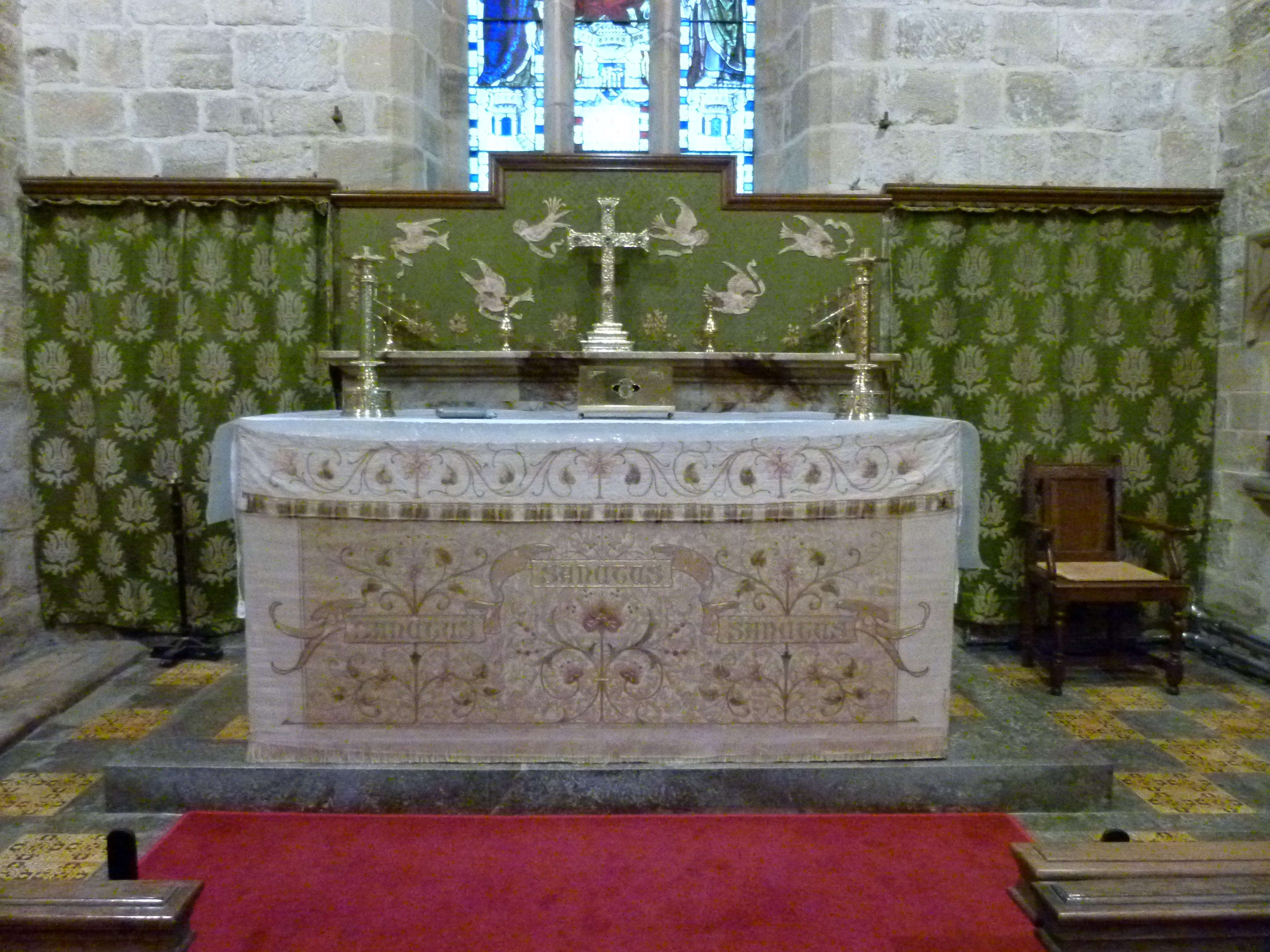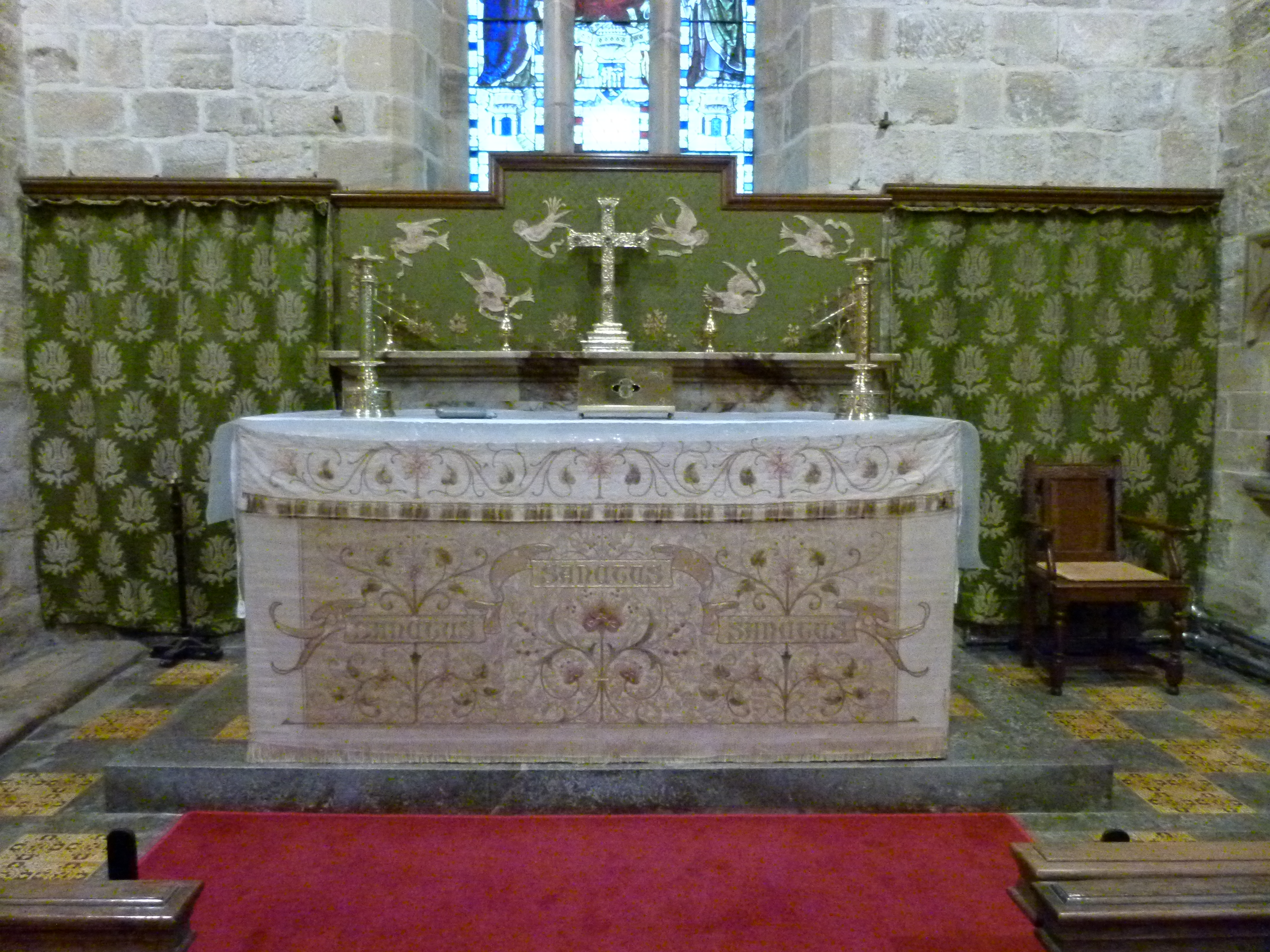

These pictures show the embroidered dossal which has recently been cleaned and framed and is now displayed in the bell tower recess.
It is well worth a closer look!
Mike Winstanley has done some research about it, and his article follows:
Embroidered Dossal by Aldam Heaton (1887)
(later remounting: cleaned and framed 2018)
The photo shows its original setting as briefly reconstructed in January 2018. Its setting explains why the east window only has plain glass at the bottom. In its early years it must have looked magnificent, backed with ‘red super cloth with red velvet orphreys’ (decorated borders). Traces of the original red are still visible behind the birds’ feathers. The doves represent six of the seven gifts of the Holy Spirit: Consilium (counsel), Scientia (knowledge), Pietas (piety), Intellectus (understanding), Sapienta (wisdom) and Fortitudo (fortitude). The original design may also have included the words ‘Timor Domino’ (Fear the Lord) in the centre above the cross. This design reflected the high church decoration favoured at the time of renovation in 1887.
It was designed by John Aldam Heaton (1830-97) whom the Foster family of Hornby Castle commissioned to supply all the decorative brass and fabrics: the cross and candlesticks; the alms bowl; frontal and superfrontal for the altar; hassocks; altar kneelers; communicant mats; collection bags; embroidered cloths for hanging in the piscina and sedilia and side hangings to the altar. The Fosters also used his fabric designs in nearby Hornby church in 1890. His total bill was over £227. By contrast, Paley and Austin, the church architects, were paid just £144. The dossal and frame cost £38 10s including £3 10s for ‘commencing the embroidery’. A contemporary press report noted that this was ‘worked’ by Mrs Moore of Wenning Cottage to his designs. Mrs Moore also contributed £30 towards the cost. The bill would clearly have been much higher if the work had been entirely carried out in his studio.
John Aldam Heaton (1830-1897), little known today, was regarded as one of the leading internal designers of the late 19th century. He was particularly renowned for his church decorations. Initially he was a cloth manufacturer living near Bingley with a mill in Bradford. It is likely, therefore, that he was a longstanding acquaintance of the Fosters whose textile firm was at Queensbury near Bradford. His firm supplied cloth to the famous firm established by arts and crafts designer William Morris. By the early 1860s he had connections with the artists like Daniel Gabriel Rossetti, who stayed at his house where he designed a stained glass window and painted a portrait of his wife, Ellen. Heaton was instrumental in getting Morris’s firm the contract for the installation of stained glass windows in Bradford Cathedral.
His passion for art led him to set up in London as an interior designer in the 1870s. His catalogues illustrate the wide range of internal decorative work which his firm undertook. He was particularly well known for church decoration and embroidery. In his book of essays, Beauty and Art (1897), he recommended the use of fabrics to introduce ‘colour and softness and variety of form’ into otherwise bare sanctuaries. He and his wife helped found the Royal School of Art Needlework in South Kensington museum (now the V&A) and exhibited regularly in the Arts and Crafts Exhibitions from the late 1880s. After his death, his firm, Aldam Heaton & Co., were responsible for designing the interiors for White Star liners, including Titanic.
The V & A in Kensington holds some fragments of Heaton’s wallpaper designs but there would seem to be few known surviving embroideries. This is not surprising. As he acknowledged, church fabrics were unlikely to last longer than 50 years. This dossal, therefore, appears to be a rare documented example of the work of a leading Victorian designer. Despite the inevitable ravages of time it is remarkable that its essential features have survived so well after more than 130 years in a parish church.
Michael Winstanley 2018, Tatham History Society, www.tathamhistory.org.uk
BREWPOINT
As can be seen in the photograph below, the installation of the "Brewpoint" has now taken place. It was made by Tony Sedgwick, who was helped with the installation by a team of volunteers.
WC
This has been installed in the Vestry.
Photographs of the processes and some of the installation "team" are published below....
UPHOLSTERY COURSES
These have now commenced in the Church.
For further information please click here:
TUNSTALL VICARAGE:
Amma Judith OCMM & Sister Sue OCMM ( Revd. Canon Dr Sue Williams) have now moved into the revamped Vicarage at Tunstall and are already making an invaluable contribution to the Benefice.
For further information about the OCMM (The Order of the Companions of Martha & Mary) please click here.